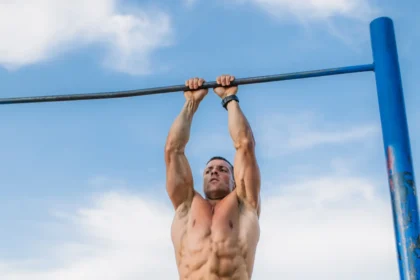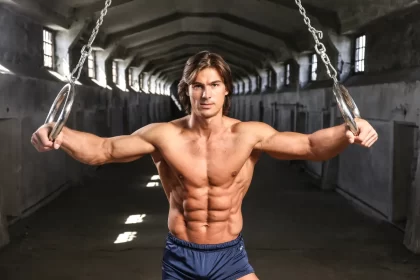With the grace of a swan and the strength of a lion, Olympic gymnasts captivate audiences around the world with their awe-inspiring performances. Each twist, turn, and somersault executed flawlessly seems to defy gravity itself, leaving spectators breathless in wonder.
How do these athletes achieve such remarkable scores that propel them to gold medal glory? Let’s find out the secret behind it.
Contents
Rigorous Training and Physical Preparation
The rigorous training and physical preparation of Olympic gymnasts are foundational to their success, encompassing a multidimensional approach that targets strength, flexibility, endurance, and technique. This intensive regimen is not just about honing the specific skills required for various apparatuses but also about developing a physique capable of withstanding the demands of high-level competition.
1. Strength Training
Strength is paramount for gymnasts, as it underpins every movement, from powerful vaults to steady balance beam routines.
Gymnasts engage in specialized strength training that targets core muscles, upper body, and lower body strength, ensuring they have the power to execute explosive jumps and maintain control in static holds. This training often includes bodyweight exercises, resistance training, and plyometrics to improve muscle power and endurance.
2. Flexibility and Mobility Work
Flexibility is another critical aspect of a gymnast’s training regimen. It not only allows for the execution of high-amplitude movements but also reduces the risk of injuries.
Gymnasts dedicate significant portions of their training to stretching and mobility exercises, focusing on increasing the range of motion in key joints like the hips, shoulders, and back. This level of flexibility is crucial for splits, leaps, and contortions required in routines.
3. Technical Skill Development
The core of gymnastic training revolves around the relentless practice of technical skills. This involves the repetition of individual elements to achieve perfect form and execution.
Gymnasts spend countless hours practicing on the apparatuses (vault, uneven bars, balance beam, and floor) to refine their techniques, from basic skills to the most advanced and difficult elements. Coaches play a crucial role in this process, providing feedback and adjusting to ensure techniques are executed correctly.
4. Endurance Training
Despite the relatively short duration of gymnastics routines, high levels of endurance are necessary to maintain peak performance from start to finish.
Endurance training ensures that gymnasts can execute their routines with consistent energy levels and prevent fatigue from impacting their performance. Cardiovascular exercises, circuit training, and routine run-throughs are incorporated into training schedules to build stamina.
5. Recovery and Injury Prevention
Given the intensity of gymnastics training, recovery practices, and injury prevention strategies are integral to a gymnast’s regimen.
This includes proper warm-up and cool-down routines, the use of physiotherapy and massage to facilitate muscle recovery, and careful monitoring of any signs of overuse or injury. Nutrition and hydration also play vital roles in recovery, ensuring the body has the necessary resources to repair and strengthen.
Technical Mastery and Execution
Technical mastery and execution in Olympic gymnastics represent the pinnacle of an athlete’s dedication, skill, and precision. This critical aspect of gymnastics is where years of rigorous training culminate in performances that are evaluated for their technical perfection, difficulty, and artistry.
Achieving technical mastery involves a deep understanding of each element’s mechanics and the ability to execute them with flawless precision under the high-pressure environment of competition.
1. Mastery of Skills and Elements
Technical mastery begins with the athlete’s ability to perform a wide array of gymnastics skills and elements with impeccable form. This includes everything from basic foundational skills to the most complex and high-difficulty maneuvers specific to each apparatus.
Gymnasts must demonstrate precise body positions, exact hand placements, and correct timing for each skill. The perfection of these elements requires relentless practice, with gymnasts performing thousands of repetitions to ensure consistency and reliability in their execution.
2. Difficulty and Innovation
The difficulty of a routine significantly influences scores in competitive gymnastics. Athletes and their coaches carefully craft routines that incorporate elements with high-difficulty values, pushing the boundaries of the sport.
However, adding more difficult skills increases the risk of execution errors. Therefore, gymnasts must achieve a balance between maximizing difficulty and maintaining a level of precision that minimizes deductions. Innovation plays a role here, as athletes often strive to introduce new skills or unique combinations to set themselves apart, requiring an even greater level of technical mastery.
3. Execution Quality
The quality of execution is paramount in gymnastics scoring, with judges focusing on the precision of movements, the smoothness of transitions, and the overall fluidity of the routine.
Deductions are made for errors such as wobbles, steps on landings, falls, and deviations from the ideal form, such as bent arms or legs, flexed feet, and improper body alignments. The margin for error is exceedingly small, and even minor mistakes can significantly impact an athlete’s score, making the quality of execution a critical determinant of success.
4. Consistency Under Pressure
Technical mastery is not solely about the ability to perform skills in training; it also encompasses the gymnast’s ability to consistently deliver these skills in the high-stakes competition environment.
This requires mental fortitude, as athletes must execute their routines with the same precision under the watchful eyes of judges and audiences, often with medals and national pride on the line. Achieving this consistency under pressure is a hallmark of the world’s top gymnasts.
5. Adherence to the Code of Points
The International Gymnastics Federation’s Code of Points is the bible of gymnastics, detailing the difficult value of skills and the criteria for execution and artistry. Gymnasts and coaches meticulously study this code to understand how to maximize their scores through strategic routine composition and flawless execution.
Technical mastery includes a deep familiarity with these rules and the ability to apply them in the construction and performance of routines, ensuring that every movement contributes positively to the overall score.
Strategic Routine Composition
Strategic routine composition in Olympic gymnastics is a nuanced and critical aspect of an athlete’s path to success. This strategic process involves careful selection and sequencing of elements, choreography that complements the gymnast’s style, and adherence to the Code of Points to ensure every movement contributes to the overall score.
1. Alignment with the Code of Points
The foundation of strategic routine composition is a thorough understanding of the International Gymnastics Federation’s (FIG) Code of Points, which dictates the difficulty value of each skill and the criteria for execution and composition requirements.
Coaches and gymnasts meticulously analyze this code to identify opportunities to incorporate high-value elements that the gymnast can perform with high execution quality. This includes not just the selection of individual skills but also understanding how combinations of skills can increase difficulty scores or fulfill specific composition requirements.
2. Balancing Difficulty and Execution
One of the most critical decisions in routine composition involves balancing the difficulty of elements with the gymnast’s ability to execute them flawlessly. Including more difficult elements can significantly increase a routine’s start value, but any errors in execution can lead to deductions that outweigh the potential benefits.
Therefore, coaches and athletes must carefully evaluate which skills to include based on the athlete’s consistency and precision in execution. This often involves trade-offs, where a slightly less difficult routine performed with perfection can score higher than a more challenging routine with execution errors.
3. Showcasing Strengths and Minimizing Weaknesses
Strategic routine composition also focuses on showcasing a gymnast’s strengths while minimizing exposure of their weaknesses. This means selecting elements and sequences that highlight the athlete’s best qualities, whether it’s exceptional flexibility, powerful tumbling, or intricate beam work.
At the same time, routines are crafted to limit the inclusion of elements that might expose weaknesses or result in higher deductions. This personalized approach ensures that routines are tailored to the unique capabilities of each gymnast, allowing them to shine in competition.
4. Choreography and Artistry
Beyond the technical selection of skills, choreography plays a vital role in strategic routine composition. Choreography is used not only to fulfill artistic requirements but also to seamlessly connect elements, creating a fluid and engaging performance that captivates judges and audiences alike.
Effective choreography can enhance the perceived difficulty and execution quality of a routine, with smooth transitions, expressive movements, and a narrative quality that elevates the overall impression of the performance.
5. Adjustments and Flexibility
The composition of routines is not static; it evolves over time based on the gymnast’s development, changes in the Code of Points, and strategic decisions made in response to competition outcomes.
Coaches and athletes must remain flexible, ready to make adjustments to routines as needed. This could involve substituting skills, refining choreography, or reevaluating the balance between difficulty and execution based on performance feedback and the competitive landscape.
Mental Toughness and Competitive Strategy
Mental toughness and competitive strategy in the realm of Olympic gymnastics are complex, multidimensional constructs that play a critical role in an athlete’s journey toward achieving peak performance. These elements are not only about physical preparation but also involve deep psychological resilience, strategic foresight, and the nuanced execution of well-planned tactics.
1. Deepening Mental Toughness
Mental toughness in gymnastics transcends basic psychological resilience, embedding itself in the very fabric of an athlete’s psychological makeup. It encompasses several key attributes:
- Resilience to Adversity: The journey of an Olympic gymnast is punctuated with challenges, including injuries, performance slumps, and intense competition. Mental toughness is characterized by the capacity to rebound from these adversities, viewing them as opportunities for growth rather than insurmountable obstacles.
- Consistency under Pressure: The hallmark of mental toughness is the ability to deliver consistent performances, especially in high-pressure situations. This requires maintaining composure, utilizing stress as a motivator rather than a hindrance, and executing routines with the same precision in competition as in practice.
- Emotional Control: Athletes must master their emotions to focus on the task at hand. This involves controlling nerves, managing expectations, and staying calm and collected, enabling them to make clear-headed decisions during crucial moments.
2. Strategic Competitive Planning
Competitive strategy involves a comprehensive understanding of the competitive landscape, an athlete’s capabilities, and how to navigate through the challenges of Olympic competition effectively. This strategic planning includes:
- Understanding the Competition: Athletes and coaches analyze competitors’ strengths, weaknesses, and likely strategies. This intelligence informs training focus, routine construction, and competition-day tactics, allowing gymnasts to capitalize on their strengths while exploiting competitors’ vulnerabilities.
- Routine Customization and Adaptation: Strategic routine composition is tailored not only to showcase the gymnast’s abilities but also to adapt to judges’ preferences and scoring trends. This dynamic approach requires continuous adjustment based on feedback from competitions and changes in the Code of Points.
- Psychological Tactics: Strategic use of psychological tactics can be a part of competitive strategy. This may include the timing of peak performances, managing public expectations, and even the order of apparatus engagement to either build momentum or apply pressure on competitors.
3. Integrating Strategy with Mental Toughness
The integration of mental toughness and competitive strategy is a dynamic process that evolves. Successful gymnasts navigate this process by:
- Aligning Mental and Physical Preparation: Athletes integrate mental toughness exercises into their physical training routines, ensuring that psychological resilience is built alongside physical strength and technical skill.
- Scenario Planning: Athletes and coaches engage in scenario planning, preparing for various competition-day possibilities. This preparation includes strategizing for different competitive outcomes, which builds mental flexibility and reduces the impact of unexpected events.
- Feedback Loops: Continuous feedback loops between coaches, athletes, and support staff ensure that strategies are refined and mental toughness is reinforced. This ongoing dialogue allows for the adjustment of tactics and mental conditioning approaches based on performance data and evolving competitive contexts.
4. The Role of Support Systems
The development of mental toughness and the formulation of competitive strategy are supported by a robust support system. This includes coaches, sports psychologists, teammates, and family members who provide emotional support, technical feedback, and strategic insights.
This ecosystem plays a crucial role in developing the athlete’s mental resilience and strategic acumen, providing a foundation for the high levels of performance required in Olympic gymnastics.
Final Words
The synthesis of these elements—physical preparation, technical precision, strategic composition, artistic expression, and mental fortitude—forms the cornerstone of Olympic success.
Achieving a gold-winning score in Olympic gymnastics, therefore, is not merely a testament to an individual’s physical capabilities but a reflection of their dedication, strategic acumen, and psychological strength. It is these attributes, honed through years of preparation and competition, that distinguish the extraordinary gymnasts who achieve the highest honors in their sport, embodying the spirit of excellence that defines the Olympic Games.




